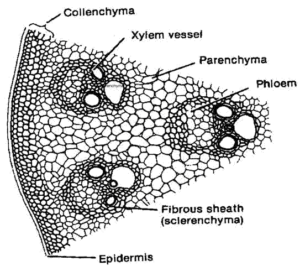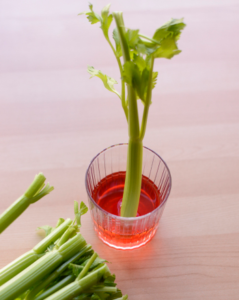Science > Biology > Botoany > Physiology > Transport in Plants
Transportation is a process in which a substance either synthesized or absorbed in one part of the body reaches another. In living things, many substances such as food, gases, minerals salts, hormones, and waste products have to be transported from one part of the body to another. Plants require inorganic substances like nitrogen, phosphorous, magnesium, manganese, sodium, etc. Soil provides such substances. In this article, we shall study transport in plants by osmosis and diffusion.
Plants and animals have a system of transporting substances throughout their body. In plants, water is the medium of transport. In higher plants (vascular plants) xylem conducts the water whereas the phloem conducts the food. All parts of the body are connected to these tissues.

To demonstrate Transportation in Plants:

Take a young herbaceous plant (e.g. sunflower) with roots and leaves. Wash the soil off the roots. Place it in a jar of water containing stains like eosin or red ink. After two days, cut sections of the stem and the root and observe it under a microscope. We see rings of red colour. This experiment shows transport of materials in plants.
Absorption:


In plants, water transport minerals salts through special tubes called xylem. Plants have root hairs on their primary and secondary roots. Plants absorb water and minerals salt from the soil with the help of root hairs. They absorb water by the process of osmosis. Osmosis is the movement of water molecules (solvent) from a lower concentration solution to a higher concentration solution through a semi permeable membrane. The concentration of the water molecules is lower in the root hair than in the soil. So the water moves into the root hairs through osmosis. Thus the cell of root hairs become turgid and exert pressure on the adjacent cells. This pressure is called root pressure.
The water and mineral diffuse from one layer to the next layer of cells and eventually reaches the xylem tubes in the centre of the root. Under the effect of root pressure, water and minerals reach xylem and continuously push forward. This root pressure is sufficient to lift water up in shrubs, small plants and small trees.
Demonstration of Osmosis ( Abbe Nollet Experiment):

A thistle funnel with a narrow long stem and wide mouth was taken. A semipermeable membrane is tied tightly around the wide mouth of the funnel. Now the stem of the funnel is filled with a sugar solution to a certain level. Then the thistle funnel is dipped in a beaker containing water with the help of an iron stand such that the broad mouth remains immersed in the water. The apparatus are left undisturbed for some time.
After some time it is observed that there is an increase in the level of sugar solution in the thistle funnel. This shows that there is at the flow of water (solvent molecules) into the solution through the semipermeable membrane. To stop this flow of solvent molecules into solution, we have to apply excess sufficient pressure from stem side of the thistle funnel on the solution. This excess pressure is the osmotic pressure.
Demonstration of Osmosis (Experiment – 2):
An egg has a shell made up of calcium carbonate. Below shell, there is a layer of semipermeable membrane. The calcium carbonate can be dissolved in acid like HCl. Place an egg in a beaker containing acid. Make sure that the egg does not float in acid. Allow it to remain in the acid until the shell completely dissolves. Leave the egg with the dissolved shell in water overnight. Remove the egg the next day and see its size. We will find that the egg will be swollen considerably.
If you carefully pierce the membrane of the egg with a needle, a jet of water will shoot into the air. It shows that the water from acid solution gets into the egg through a semipermeable membrane.
Diffusion:
Mineral and salts are absorbed by a process called diffusion. Diffusion is the movement of solute molecules of a solid, a gas or liquid from a region of high concentration region to that of low concentration region.
Difference Between Osmosis and Diffusion:
In osmosis, solvent moves from lower concentration region to higher concentration region. In diffusion, solute particles move from higher concentration region to lower concentration region.
Ascent of Sap:
After reaching xylem tubes water is conducted from the root to the stem and then to the leaves. The continuous columns of water in the xylem tubes do not break due to strong cohesive force between the water molecules. The upward movement of cell sap containing water and minerals salts in a plant is called ascent of sap.
Transpiration:

Water evaporates from the leaves through the opening on them called stomata There are two guard cells at the opening of stomata. These cells control opening and closing of stomata.
The loss of water from the aerial parts of a plant is called transpiration. When transpiration takes place, the leaves lose water and become less turgid, or less swollen. They then absorb water from the xylem tubes in the veins. They pull water from the stem, which in turn pulls water from the roots. This process is called transpirational pull. Transpirational pull works due to the formation of a continuous column of water in the xylem.
The significance of Transpiration:
Minerals salts absorbed by the roots are taken along through this column of water during the ascent of sap and the essential elements needed by the plant reach the leaves and every part of the plant.
When the temperature is high or the atmosphere is dry or when there is an air current, the rate of transpiration becomes high. If there is no sufficient water in the soil, the leaves become less turgid. Transpiration pull is very important for big plants. By this method, water and minerals reach the different part of the body of the big plant. In the night the rate of transpiration is low, hence in night water and mineral transportation takes place by root pressure.
Translocation:
Glucose (sugar) is made in the leaves during the day in presence of sunlight by the process called photosynthesis. This food is required to be transported to other parts of the plant. This transportation of food material takes place through a special tube like tissues phloem in upward and downward direction.
During day glucose is formed and it is formed is converted into starch and stored in the leaves. As the day advances and manufacture of glucose (food) take place, the starch grains become more and more abundant. About the middle of the afternoon, the starch content reaches its maximum.
At night, due to the absence of sunlight plants do not make food. Then the stored starch in the cells of the leaves gets converted back into glucose, which is soluble in water. This sugar solution and other substances move from the leaves to other parts of the plant all through the night. This movement of food substance from leaves to the different parts of the body in the phloem is called translocation.
Before the daybreak, the food-making cells in the leaves are cleared of stored food and they become ready for food manufacture.
One reply on “Transport in Plants”
Very clearly explained.